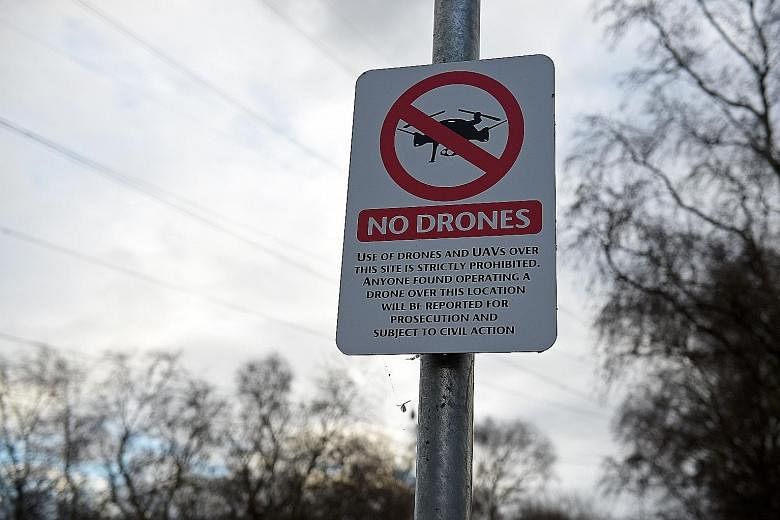LONDON • The disruption to hundreds of flights at London's Gatwick Airport after it was buzzed by small drones shows how easy it can be to mess up advanced aviation networks with simple, cheap devices.
Airports have been raided by drones before. Dubai International was briefly closed in 2016, and Wellington, New Zealand's main hub, was shuttered for 30 minutes this year when a mystery craft was spotted close to the runway.
While airfield operators around the world have been girding for more drone disruptions and safety issues, the length and severity of the chaos at Gatwick is a stunning eye-opener, said Mr Christopher Oswald, vice-president for safety and regulatory affairs at trade group Airports Council International.
"It just represents all these very thorny challenges, which Gatwick does really bring into very stark relief," he said.
The law already is clear in most jurisdictions, and penalties for violation can be severe. In Britain, drones are not allowed to fly within 1km of airports and cannot climb above 122m, to avoid conflict with flight paths.
Aviation Minister Liz Sugg said the operators of the Gatwick craft could face five-year jail terms if caught. That is a big "if".
Modern airports rival the size of some cities, making their perimeters almost impossible to permanently police. Nearby buildings also offer almost limitless opportunities for drone operators to hide while controlling their devices.
The latest drone technology adds a new dimension. Relatively affordable unmanned devices can be flown miles away from an operator using remote video that shows the equivalent of a plane's cockpit view.
British police said the Gatwick incursions were clearly deliberate, as the drones variously appeared, vanished and then emerged again from Wednesday night to Thursday. That could shift attention from how best to regulate drone flights to practical ways of neutralising the threat and finding scofflaws.
United States law enforcement and homeland security agencies are drafting standards that would require all but the tiniest drones to broadcast their identities and positions so the authorities could identify operators who have crossed the line.
The Federal Bureau of Investigation and other agencies blocked aviation regulators from moving ahead two years ago with rules allowing more drones over crowds until the authorities could move ahead to address security concerns.
Another mechanism that may help is geofencing. Drone makers use built-in GPS to alert a pilot who is about to fly into restricted skies, such as around airports and prisons. But such systems have vulnerabilities and they raise even more vexing legal and political issues.
Tracking technology works for lawful operators who blunder into the wrong place, but criminals may subvert such efforts. And GPS limitations would not stop deliberate attempts to interfere with flights.
The US Federal Aviation Administration last year advised airports not to experiment with the growing number of anti-drone products as the agency had not had a chance to vet them. Solutions such as jamming radio signals could create safety problems by interfering with existing aviation radio systems.
Some technologies are illegal. The US Federal Communications Commission bans broadcasting on frequencies used by other devices. There are also concerns on whether tracking a drone's radio signal could be seen as prohibited wiretapping.
There are many remedies - and proposals get pretty creative. Dutch police in 2016 proposed using trained raptors to take out rogue devices, a variation on employing hawks to scare birds from runways. Colorado-based Liteye Systems has developed a system that uses radio signals to halt a drone and force it to land, while Australia-based DroneShield is developing a device resembling a traditional ballistic weapon.
BLOOMBERG

